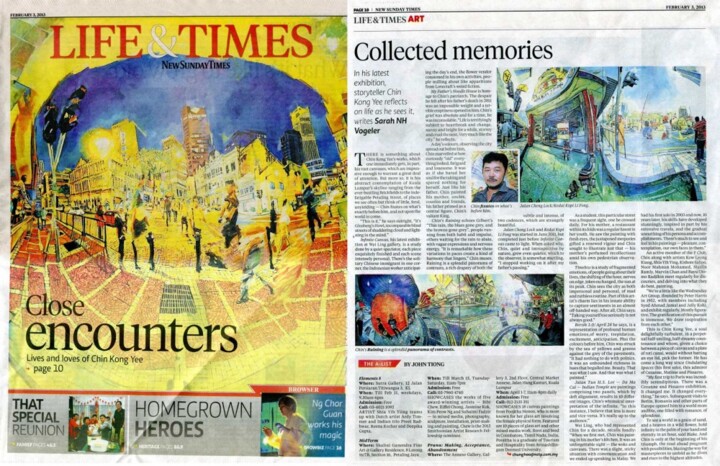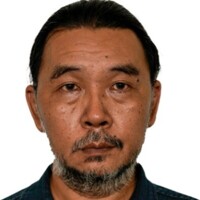Chin Kong Yee
ART: Collected memories
In his latest exhibition, storyteller Chin Kong Yee reflects on life as he sees it, writes Sarah NH Vogeler
THERE is something about Chin Kong Yee’s works, which one immediately gets, in part, his vast canvases, which are impressive enough to warrant a great deal of attention. But more so, it is his abstract contemplation of Kuala Lumpur’s skyline ranging from the ever-bustling Brickfields to the indefatigable Petaling Street, of places we see often but think of little, feral, unyielding — Chin fixates on what’s exactly before him, and not upon the world to come.
“This is it,” he says outright, “it’s Ginsberg’s Howl, incomparable blind streets of shuddering cloud and lightning in the mind.”
Infinite Canvas, his latest exhibition at Wei Ling gallery, is a study done by a quiet spectator, each piece exquisitely finished and each scene intensely personal. There’s the solitary Chinese immigrant in one corner, the Indonesian worker anticipating the day’s end, the flower vendor consumed in his own activities, people milling about like apparitions from Lovecraft’s weird fiction.
My Father’s Noodle House is homage to Chin’s patriarch. The despair he felt after his father’s death in 2011 was an impossible weight and a terrible emptiness opened in him. Chin’s grief was absolute and for a time, he was inconsolable. “Life is terrifyingly subject to heartbreak and change, sunny and bright for a while, stormy and cruel the next. Very much like the city,” he reflects.
A day’s sojourn, observing the city spread out before him, Chin marvelled at how curiously “old” everything looked, fatigued and lonesome. It was as if she bared her soul for the taking and spared nothing for herself. Just like his father.
Chin painted his mother, uncles, cousins and friends, his father primed as a central figure, Chin’s valiant King.
Chin’s Raining echoes Gilbert’s “This rain, the blues gone grey, and the browns gone grey”, people running from both habit and impulse, others waiting for the rain to abate, with vague expressions and nervous energy. “It is remarkable how these variations in paces create a kind of harmony that lingers,” Chin muses. Raining is a splendid panorama of contrasts, a rich drapery of both the subtle and intense, of two cadences, which are strangely beautiful.
Jalan Cheng Lock and Kedai Kopi Li Fong was started in June 2011, but completed just before Infinite Canvas came to light. When asked why, Chin, quiet and introspective by nature, grew even quieter, which to the observer, is somewhat startling. “I stopped working on it after my father’s passing.”
As a student, this particular street was a frequent sight, one he crossed daily. For his mother, a restaurant within its folds was a regular haunt in her youth. He saw the painting with fresh eyes, the juxtaposed memories gifted a renewed vigour and Chin sought to illustrate just that — his mother’s perfumed recollections amid his own pedestrian observation.
Timeless is a study of fragmented emotions, of people going about their lives, the shifting of the hour, nerves on edge, jokes exchanged, the sun at its peak. Chin sees the city as both impersonal and personal, of mad and ruthless routine. Part of this artist’s charm lies in his innate ability to capture sentiments in an almost off-handed way. After all, Chin says: “Taking yourself too seriously is not always good.”
Bersih 3.0/ April 28 he says, is a representation of profound human emotions,of worry, trepidation, excitement, anticipation. Plus the colours before him, Chin was struck by the sea of yellows and greens against the grey of the pavements. “It had nothing to do with politics. It was an unbounded richness in hues that beguiled me. Beauty. That was what I saw. And that was what I painted.”
Jalan Tun H.S. Lee — Da Ma Cai — Indian Temple are paintings comprising two panels, which by deft alignment, results in 10 different images, Chin’s whimsical interpretation of the infinite. “In this instance, I believe that less is more and vice-versa. It’s really up to the audience.”
Wei Ling, who had represented Chin for a decade, recalls fondly: “When we first met, Chin was painting in his mother’s kitchen. It was an unforgettable sight — the woks and canvases. There was a slight, sticky situation with communication and we ended up speaking in Malay. We had his first solo in 2003 and now, 10 years later, his skills have developed stunningly, inspired in part by his extensive travels, and the gradual unearthing of his persona and accomplishments. There’s much to see and feel in his paintings — pleasure, contemplation, our own faces in them.”
An active member of the F Club, Chin along with artists Kow Leong Kiang, Shia Yih Ying, Kishore Sahoo, Noor Mahnun Mohamed, Maslin Ramly, Marvin Chan and Bayu Utomo Radjikin meet regularly for discourses, and delving into what they do best, painting.
“We’re a little like the Wednesday Art Group, (founded by Peter Harris in 1952, with members including Syed Ahmad Jamal and Jolly Koh), and exhibit regularly. Mostly figurative. The gratification of this pursuit is immense. We draw inspiration from each other.”
This is Chin Kong Yee, a soul delightfully turbulent, in a perpetual half-smiling, half-dreamy countenance and whom, given a choice between a piece of canvas and a plate of roti canai, would without batting an eye lid, pick the former.
He has come a long way since Undulating Spaces (his first solo), this admirer of Cezanne, Matisse and Pissarro.
“My first trip to Paris was incredibly serendipitous. There was a Cezanne and Pissarro exhibition. It changed me. It changed everything,” he says. Subsequent visits to Berlin, Romania and other parts of Europe opened him to a world more audible, one filled with romance, of splendour.
To see a world in a grain of sand, and a heaven in a wild flower, hold infinity in the palm of your hand and eternity in an hour, said Blake. And Chin is only at the beginning of his triumph, the road ahead pregnant with possibilities, blazing the way for masterpieces to unfold as he dives and rises to the highest altitudes.
Read more: ART: Collected memories - Sunday Life & Times - New Straits Times http://www.nst.com.my/life-times/sunday-life-times/art-collected-memories-1.211944#ixzz2Of3uq4ha


